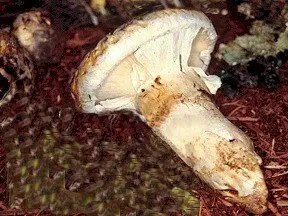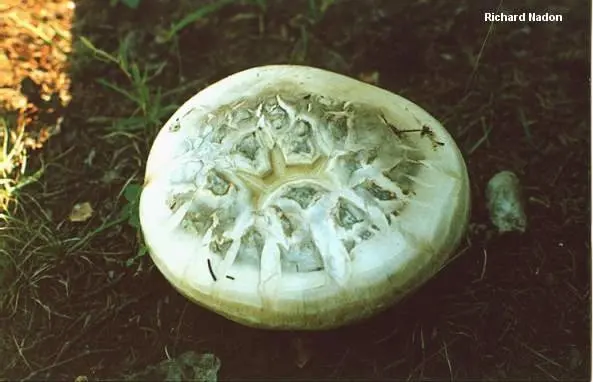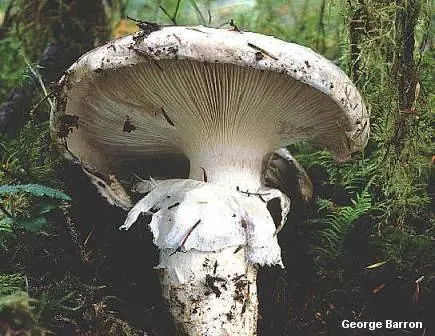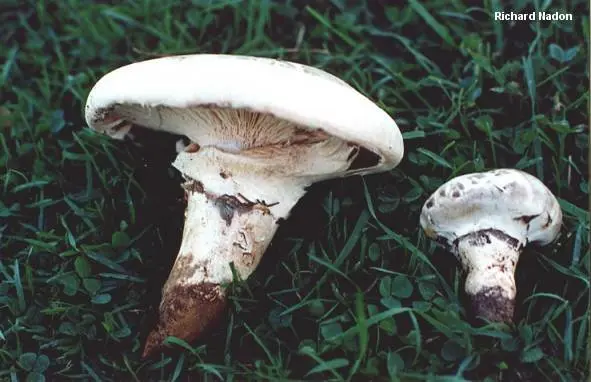Swollen catatelasma (Catathelasma ventricosum)
- Division: Basidiomycota (Basidiomycetes)
- Subdivision: Agaricomycotina (Agaricomycetes)
- Class: Agaricomycetes (Agaricomycetes)
- Subclass: Agaricomycetidae (Agaricomycetes)
- Order: Agaricales (Agaric or Lamellar)
- Family: Catathelasmataceae (Catatelasma)
- Genus: Catathelasma (Katatelasma)
- Type: Catathelasma ventricosum (Swollen catatelasma)
- Sakhalin champignon
 Sakhalin champignon – grows in summer and autumn in coniferous forests. On the territory of Our Country, it is found in coniferous and mixed forests of the Far East. This fungus often develops characteristic gray spots on its whitish cap. Descending plates, a rather large dangling double ring on the stem, dense white flesh with a mild mushroom (NOT flour!) smell, without much taste, and a rather considerable size – all this makes the mushroom quite recognizable.
Sakhalin champignon – grows in summer and autumn in coniferous forests. On the territory of Our Country, it is found in coniferous and mixed forests of the Far East. This fungus often develops characteristic gray spots on its whitish cap. Descending plates, a rather large dangling double ring on the stem, dense white flesh with a mild mushroom (NOT flour!) smell, without much taste, and a rather considerable size – all this makes the mushroom quite recognizable.
Confusion periodically arises with Catathelasma ventricosum (Sakhalin mushroom), as many (foreign, translator’s note) authors describe it with a brown cap and floury smell, which is typical for Catathelasma Imperiale (imperial mushroom). Western authors have attempted to separate these two species based on cap size and microscopic examination, but so far this has not been successful. The cap and spores of Catathelasma Imperiale (Imperial Mushroom) are theoretically slightly larger, but there is a significant overlap in the ranges of both sizes: both caps and spores.
Until DNA studies are carried out, it is proposed to separate Catathelasma ventricosum (Sakhalin mushroom) and Catathelasma Imperiale (Imperial mushroom) in the old fashioned way: by color and by smell. Sakhalin mushroom has a whitish cap that turns gray with age, while imperial mushroom has a yellowish tint when young, and darkens to brown when ripe.

Description:
The entire fruiting body of the fungus at the beginning of growth is dressed in a common light-brown veil; during growth, the veil is torn at the level of the edge of the cap and breaks into pieces that quickly fall off. The veil is white, strongly stretching and thinning with growth, covering the plastics for a long time. After the rupture, it remains in the form of a ring on the leg.
Hat: 8-30 centimeters or more; first convex, then becomes slightly convex or almost flat, with a folded edge. Dry, smooth, silky, whitish in young mushrooms, becoming more grayish with age. In adulthood, it often cracks, exposing white flesh.

Plates: Adherent or weakly decurrent, frequent, whitish.
Stem: About 15 centimeters long and 5 centimeters thick, often thickened towards the middle and narrowed at the base. Typically deeply rooted, sometimes almost completely underground. Whitish, light brownish or grayish in color, with a hanging double ring, which, according to various sources, can either remain on the stem for a long time, or disintegrate and fall off.
Pulp: White, hard, dense, does not change color when broken and pressed.
Smell and taste: The taste is indistinct or slightly unpleasant, the smell of mushrooms.
Spore powder: White.
Ecology: Probably mycorrhizal. It grows in summer and autumn alone or in small groups on the ground under coniferous trees.

Microscopic examinations: spores 9-13*4-6 microns, smooth, oblong-elliptical, starchy. Basidia about 45 µm.
Edibility: Considered a high quality edible mushroom. In some countries it is of commercial importance. It is used in any form, it can be boiled, fried, stewed, marinated. Since the mushroom does not have its own pronounced taste, it is considered an ideal addition to both meat and vegetable dishes. When harvesting for the future, you can dry and freeze.
Similar species: Catathelasma Imperiale (Imperial mushroom)









